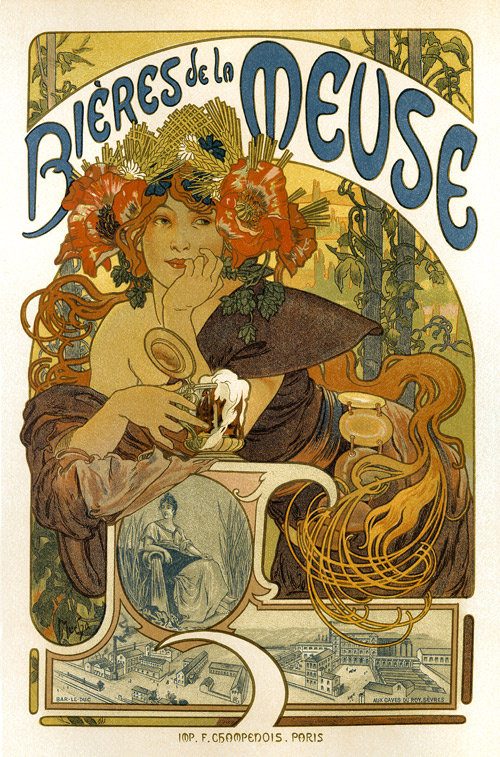Meuse - 1897
VINTAGE FRENCH POSTER - GICLÉE PRINT
This vintage French poster is an example of "Affiche
Artistique",
advertising beer, titled
"Bières de la Meuse".
The artist was Alphonse Mucha and the poster was published in 1897.
Dimensions: 16" x 24"
|
Item# |
Title |
Choose: |
Shp Wt |
Price |
Click to buy |
|
1W-ART-091-1 |
Meuse, 1897 |
Archival Paper |
2 lbs. |
$29.95 |
Add to Basket |
|
1W-ART-091-5 |
Meuse, 1897 |
Repositionable Peel & Stick Fabric* |
2 lbs. |
$39.95 |
Add to Basket |
|
*Peel & Stick: Repositionable
self-adhesive fabric that resists water, wrinkles and tears.
Can be repositioned with ease without damaging walls. No
need for screws, tape or push-pins, simply peel and stick. |
Artists in the late 1800s found
opportunities to present their work to the masses through advertising art
that began to appear as billboards and posters, plastering the streets of
Paris. “Affiche Artistique” was the term that the French used to describe a
poster that contained artistic expression. The art was so impressive
to the public, people began to collect the posters as soon as they went up,
which is why they are so scarce today. Artists such as Henri
Toulouse-Lautrec, Alphonse Mucha, Jules Chéret, Théophile-Alexandre
Steinlen, Pierre Bonnard and Eugène Grasset contributed to the creative body
of work that became what some called “a free museum for the masses”.
The craze for collecting these examples of modern art was even given the
name, "affichomanie", meaning “artistic poster mania”. Collectors today pay
hundreds, if not thousands for original prints of these rare posters.
We offer these exceptional vintage poster reproductions in
the highest possible print quality. Superior to most reproductions
currently available on the market, our gallery quality prints are suitable
for display in an art gallery or museum. We begin with an ultra high
resolution scan of the original artifact which we leave untouched, leaving
intact the slightly distressed vintage character desirable in a collectible
piece of this era. Our state of the art, giclée reproduction process
uses the latest technology: microscopic droplets of ink that render such a
high resolution, that every minute detail of the original is intact.
Every pen line and brush stroke is visible. Even very faint pencil
lines are also visible due to the incredibly high quality of the
reproduction process. Our 8 color, archival quality inks and giclée
printing process provide the most accurate color reproduction & are proven
to last over a hundred years. Posters are available printed on museum
quality archival paper or on repositionable media that allow you to plaster
your walls with the “Affiche Artistique”, just as they were originally
intended to be displayed.
About the artist:
Alphonse Mucha
Czech, 1860-1939
Alphonse Maria Mucha was born in
Ivančice, Moravia. As a young man, he was sponsored to study at the
Munich Academy of Fine Arts before arriving in Paris in 1887, where he
continued his studies at Académie Julian and Académie Colarossi.
 He
volunteered his services when he happened to hear of an urgent need for a
poster to advertise a new play at the Théâtre de la Renaissance. He seized
the opportunity and completed the project within two weeks. Mucha’s
poster for Sarah Bernhardt’s Gismonda in 1894 launched his career as a
successful artist in Paris. Sarah Bernhardt herself was so pleased
with his artwork that she began a six-year contract with Mucha to produce
her posters. He
volunteered his services when he happened to hear of an urgent need for a
poster to advertise a new play at the Théâtre de la Renaissance. He seized
the opportunity and completed the project within two weeks. Mucha’s
poster for Sarah Bernhardt’s Gismonda in 1894 launched his career as a
successful artist in Paris. Sarah Bernhardt herself was so pleased
with his artwork that she began a six-year contract with Mucha to produce
her posters.
Mucha’s designs began to be applied
to jewelry, carpets and wallpaper as well as posters and illustrations in
books and advertisements. His use of pale pastels and classically
styled beauties became known as the Mucha Style, and then as Art Nouveau
(New Art).
Mucha was dissatisfied that his
commercial work achieved such success, while he desired to communicate a
spiritual message through art. After marrying Marušca Chytilová in
Prague in 1906, Mucha and his new bride traveled to the U.S., where they
remained for four years. Mucha became devoted to promoting Slavic
nationalism and returned to Prague, where he was commissioned to decorate
the Theatre of Fine Arts. Mucha designed the new postage stamps,
banknotes and other documents for the newly independent state of
Czechoslovakia after World War I.
 Mucha’s
final fine art masterpiece, The Slav Epic, took many years to complete.
It is a series of twenty large paintings that depict the history of the
Slavic people. A lifelong dream of Muchas to create, he presented his
masterpiece to the city of Prague in 1928. Mucha’s
final fine art masterpiece, The Slav Epic, took many years to complete.
It is a series of twenty large paintings that depict the history of the
Slavic people. A lifelong dream of Muchas to create, he presented his
masterpiece to the city of Prague in 1928.
Mucha was one of the first arrested
by the Gestapo when Czechoslovakia was occupied by German troops in 1939.
Eventually released, he died the same year of pneumonia, possibly weakened
by the events of his arrest and interrogation.
|
 |